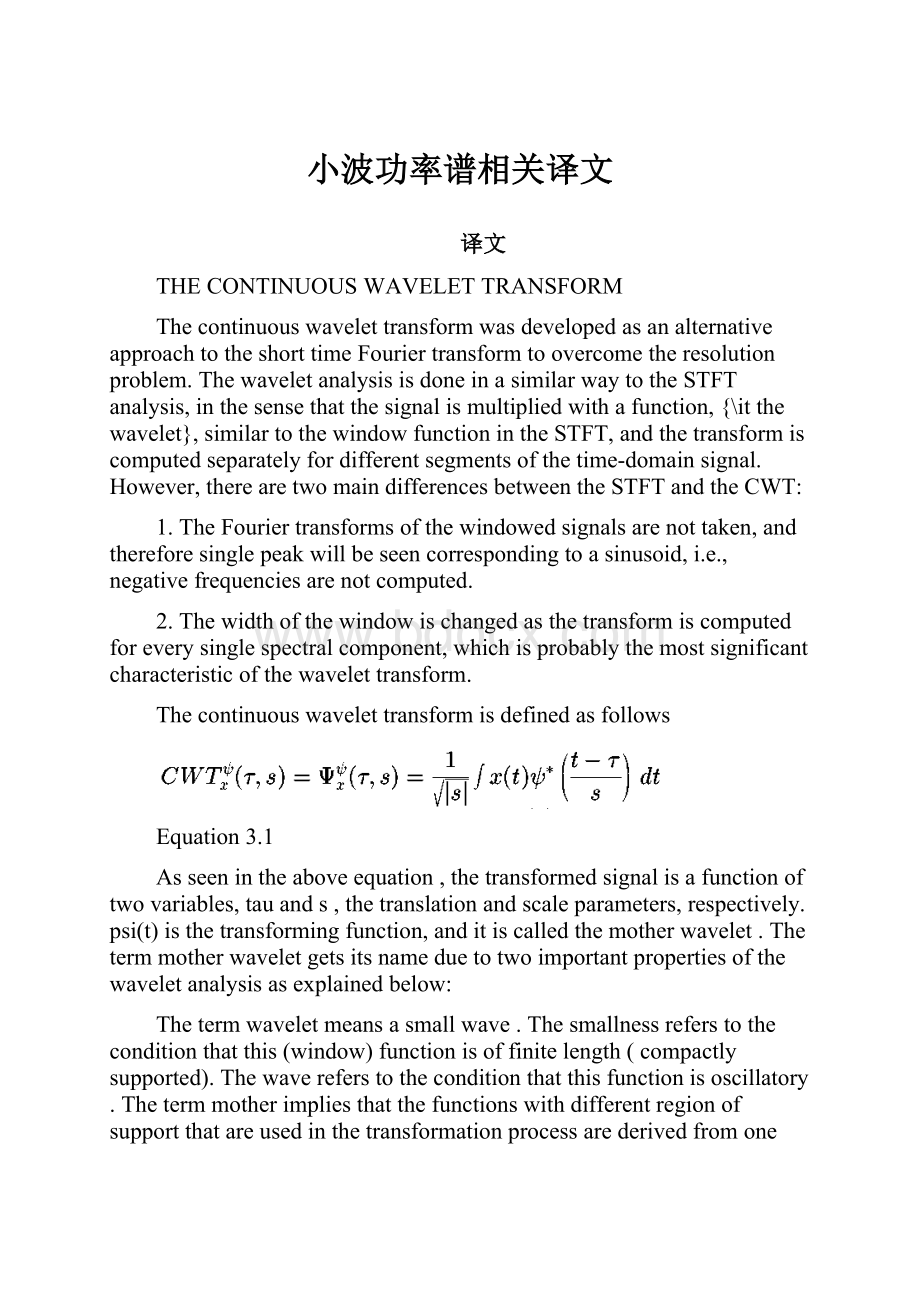小波功率谱相关译文.docx
《小波功率谱相关译文.docx》由会员分享,可在线阅读,更多相关《小波功率谱相关译文.docx(16页珍藏版)》请在冰豆网上搜索。

小波功率谱相关译文
译文
THECONTINUOUSWAVELETTRANSFORM
ThecontinuouswavelettransformwasdevelopedasanalternativeapproachtotheshorttimeFouriertransformtoovercometheresolutionproblem.ThewaveletanalysisisdoneinasimilarwaytotheSTFTanalysis,inthesensethatthesignalismultipliedwithafunction,{\itthewavelet},similartothewindowfunctionintheSTFT,andthetransformiscomputedseparatelyfordifferentsegmentsofthetime-domainsignal.However,therearetwomaindifferencesbetweentheSTFTandtheCWT:
1.TheFouriertransformsofthewindowedsignalsarenottaken,andthereforesinglepeakwillbeseencorrespondingtoasinusoid,i.e.,negativefrequenciesarenotcomputed.
2.Thewidthofthewindowischangedasthetransformiscomputedforeverysinglespectralcomponent,whichisprobablythemostsignificantcharacteristicofthewavelettransform.
Thecontinuouswavelettransformisdefinedasfollows
Equation3.1
Asseenintheaboveequation,thetransformedsignalisafunctionoftwovariables,tauands,thetranslationandscaleparameters,respectively.psi(t)isthetransformingfunction,anditiscalledthemotherwavelet.Thetermmotherwaveletgetsitsnameduetotwoimportantpropertiesofthewaveletanalysisasexplainedbelow:
Thetermwaveletmeansasmallwave.Thesmallnessreferstotheconditionthatthis(window)functionisoffinitelength(compactlysupported).Thewavereferstotheconditionthatthisfunctionisoscillatory.Thetermmotherimpliesthatthefunctionswithdifferentregionofsupportthatareusedinthetransformationprocessarederivedfromonemainfunction,orthemotherwavelet.Inotherwords,themotherwaveletisaprototypeforgeneratingtheotherwindowfunctions.
ThetermtranslationisusedinthesamesenseasitwasusedintheSTFT;itisrelatedtothelocationofthewindow,asthewindowisshiftedthroughthesignal.Thisterm,obviously,correspondstotimeinformationinthetransformdomain.However,wedonothaveafrequencyparameter,aswehadbeforefortheSTFT.Instead,wehavescaleparameterwhichisdefinedas$1/frequency$.ThetermfrequencyisreservedfortheSTFT.Scaleisdescribedinmoredetailinthenextsection.
TheScale
Theparameterscaleinthewaveletanalysisissimilartothescaleusedinmaps.Asinthecaseofmaps,highscalescorrespondtoanon-detailedglobalview(ofthesignal),andlowscalescorrespondtoadetailedview.Similarly,intermsoffrequency,lowfrequencies(highscales)correspondtoaglobalinformationofasignal(thatusuallyspanstheentiresignal),whereashighfrequencies(lowscales)correspondtoadetailedinformationofahiddenpatterninthesignal(thatusuallylastsarelativelyshorttime).Cosinesignalscorrespondingtovariousscalesaregivenasexamplesinthefollowingfigure.
Figure3.2
Fortunatelyinpracticalapplications,lowscales(highfrequencies)donotlastfortheentiredurationofthesignal,unlikethoseshowninthefigure,buttheyusuallyappearfromtimetotimeasshortbursts,orspikes.Highscales(lowfrequencies)usuallylastfortheentiredurationofthesignal.
Scaling,asamathematicaloperation,eitherdilatesorcompressesasignal.Largerscalescorrespondtodilated(orstretchedout)signalsandsmallscalescorrespondtocompressedsignals.Allofthesignalsgiveninthefigurearederivedfromthesamecosinesignal,i.e.,theyaredilatedorcompressedversionsofthesamefunction.Intheabovefigure,s=0.05isthesmallestscale,ands=1isthelargestscale.
Intermsofmathematicalfunctions,iff(t)isagivenfunctionf(st)correspondstoacontracted(compressed)versionoff(t)ifs>1andtoanexpanded(dilated)versionoff(t)ifs<1.
However,inthedefinitionofthewavelettransform,thescalingtermisusedinthedenominator,andtherefore,theoppositeoftheabovestatementsholds,i.e.,scaless>1dilatesthesignalswhereasscaless<1,compressesthesignal.Thisinterpretationofscalewillbeusedthroughoutthistext.
COMPUTATIONOFTHECWT
Interpretationoftheaboveequationwillbeexplainedinthissection.Letx(t)isthesignaltobeanalyzed.Themotherwaveletischosentoserveasaprototypeforallwindowsintheprocess.Allthewindowsthatareusedarethedilated(orcompressed)andshiftedversionsofthemotherwavelet.Thereareanumberoffunctionsthatareusedforthispurpose.TheMorletwaveletandtheMexicanhatfunctionaretwocandidates,andtheyareusedforthewaveletanalysisoftheexampleswhicharepresentedlaterinthischapter.
Oncethemotherwaveletischosenthecomputationstartswiths=1andthecontinuouswavelettransformiscomputedforallvaluesofs,smallerandlargerthan``1''.However,dependingonthesignal,acompletetransformisusuallynotnecessary.Forallpracticalpurposes,thesignalsarebandlimited,andtherefore,computationofthetransformforalimitedintervalofscalesisusuallyadequate.Inthisstudy,somefiniteintervalofvaluesforswereused,aswillbedescribedlaterinthischapter.
Forconvenience,theprocedurewillbestartedfromscales=1andwillcontinuefortheincreasingvaluesofs,i.e.,theanalysiswillstartfromhighfrequenciesandproceedtowardslowfrequencies.Thisfirstvalueofswillcorrespondtothemostcompressedwavelet.Asthevalueofsisincreased,thewaveletwilldilate.
Thewaveletisplacedatthebeginningofthesignalatthepointwhichcorrespondstotime=0.Thewaveletfunctionatscale``1''ismultipliedbythesignalandthenintegratedoveralltimes.Theresultoftheintegrationisthenmultipliedbytheconstantnumber1/sqrt{s}.Thismultiplicationisforenergynormalizationpurposessothatthetransformedsignalwillhavethesameenergyateveryscale.Thefinalresultisthevalueofthetransformation,i.e.,thevalueofthecontinuouswavelettransformattimezeroandscales=1.Inotherwords,itisthevaluethatcorrespondstothepointtau=0,s=1inthetime-scaleplane.
Thewaveletatscales=1isthenshiftedtowardstherightbytauamounttothelocationt=tau,andtheaboveequationiscomputedtogetthetransformvalueatt=tau,s=1inthetime-frequencyplane.
Thisprocedureisrepeateduntilthewaveletreachestheendofthesignal.Onerowofpointsonthetime-scaleplaneforthescales=1isnowcompleted.
Then,sisincreasedbyasmallvalue.Notethat,thisisacontinuoustransform,andtherefore,bothtauandsmustbeincrementedcontinuously.However,ifthistransformneedstobecomputedbyacomputer,thenbothparametersareincreasedbyasufficientlysmallstepsize.Thiscorrespondstosamplingthetime-scaleplane.
Theaboveprocedureisrepeatedforeveryvalueofs.Everycomputationforagivenvalueofsfillsthecorrespondingsinglerowofthetime-scaleplane.Whentheprocessiscompletedforalldesiredvaluesofs,theCWTofthesignalhasbeencalculated.
Thefiguresbelowillustratetheentireprocessstepbystep.
Figure3.3
InFigure3.3,thesignalandthewaveletfunctionareshownforfourdifferentvaluesoftau.ThesignalisatruncatedversionofthesignalshowninFigure3.1.Thescalevalueis1,correspondingtothelowestscale,orhighestfrequency.Notehowcompactitis(thebluewindow).Itshouldbeasnarrowasthehighestfrequencycomponentthatexistsinthesignal.Fourdistinctlocationsofthewaveletfunctionareshowninthefigureatto=2,to=40,to=90,andto=140.Ateverylocation,itismultipliedbythesignal.Obviously,theproductisnonzeroonlywherethesignalfallsintheregionofsupportofthewavelet,anditiszeroelsewhere.Byshiftingthewaveletintime,thesignalislocalizedintime,andbychangingthevalueofs,thesignalislocalizedinscale(frequency).
Ifthesignalhasaspectralcomponentthatcorrespondstothecurrentvalueofs(whichis1inthiscase),theproductofthewaveletwiththesignalatthelocationwherethisspectralcomponentexistsgivesarelativelylargevalue.Ifthespectralcomponentthatcorrespondstothecurrentvalueofsisnotpresentinthesignal,theproductvaluewillberelativelysmall,orzero.ThesignalinFigure3.3hasspectralcomponentscomparabletothewindow'swidthats=1aroundt=100ms.
ThecontinuouswavelettransformofthesignalinFigure3.3willyieldlargevaluesforlowscalesaroundtime100ms,andsmallvalueselsewhere.Forhighscales,ontheotherhand,thecontinuouswavelettransformwillgivelargevaluesforalmosttheentiredurationofthesignal,sincelowfrequenciesexistatalltimes.
Figure3.4
Figure3.5
Figures3.4and3.5illustratethesameprocessforthescaless=5ands=20,respectively.Notehowthewindowwidthchangeswithincreasingscale(decreasingfrequency).Asthewindowwidthincreases,thetransformstartspickingupthelowerfrequencycomponents.
Asaresult,foreveryscaleandforeverytime(interval),onepointofthetime-scaleplaneiscomputed.Thecomputationsatonescaleconstructtherowsofthetime-scaleplane,andthecomputationsatdifferentscalesconstructthecolumnsofthetime-scaleplane.
Now,let'stakealookatanexample,andseehowthewavelettransformreallylookslike.Considerthenon-stationarysignalinFigure3.6.ThisissimilartotheexamplegivenfortheSTFT,exceptatdifferentfrequencies.Asstatedonthefigure,thesignaliscomposedoffourfrequencycomponentsat30Hz,20Hz,10Hzand5Hz.
Figure3.6
Figure3.7isthecontinuouswavelettransform(CWT)ofthissignal.Notethattheaxesaretranslationandscale,nottimeandfrequency.However,translationisstrictlyrelatedtotime,sin